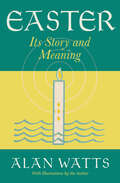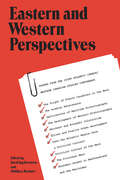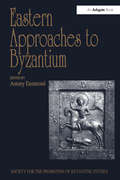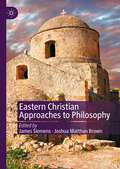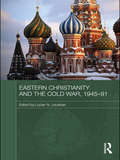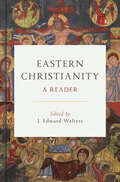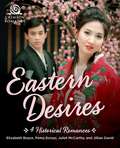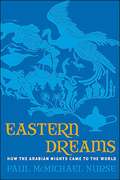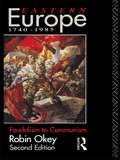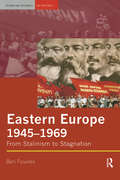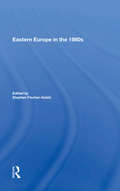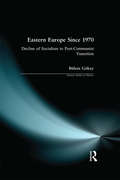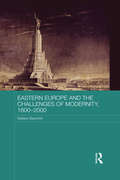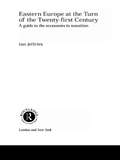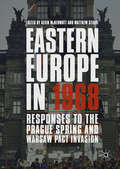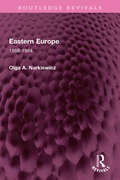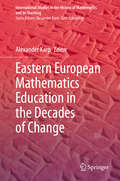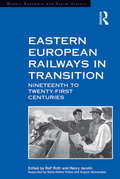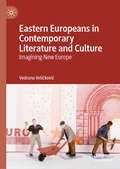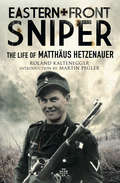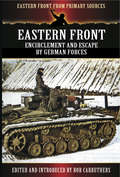- Table View
- List View
Easter: Its Story and Meaning
by Alan WattsTHE FORGOTTEN PAGAN ORIGINS OF CHRISTIANITY’S MOST EMBLEMATIC CELEBRATION “Easter — by whatever name it may be known — is a theme common to almost every religion and every people.” — Alan Watts Along with Christmas, Easter Sunday is one of the two most popular celebrations on the Church calendar. For millions of believers around the world, it encapsulates the central message of Christianity. Yet Easter has become associated with a perplexing jumble of non-Biblical customs: colorful eggs, chocolate rabbits, evening bonfires, children’s songs, mischievous games, and more. Philosopher Alan Watts proposes that these curiosities are vestiges of a tradition far older than Christianity. In Easter: Its Story and Meaning, Watts goes in search of the lost origins of Easter, taking readers with him on a kaleidoscopic tour of history, anthropology, and myth. He begins on the scorching plains of Bronze Age Mesopotamia, wanders the marble temples of imperial Rome, enters the glittering cathedrals of medieval Europe, and eventually lands in modern America. In the course of the journey, Watts unravels the multilayered symbolism of Easter and places the holiday within the broader context of world religions. He also delves into several tantalizing historical enigmas, such as: • Why is Christianity’s most sacred holiday named after a pagan goddess? • Is Jesus Christ historically unique, or is he just another example of the “dying-and-rising god” archetype common in antiquity? • How was the date of Easter calculated by the patriarchs of the early Church? • Where did the tradition of the Easter egg come from? (Could it be African?) The book closes on a lighthearted note, with a collection of weird and wonderful Easter folk traditions old and new. From beginning to end, Watts employs his keen intellect and vast erudition to uncover hidden connections between seemingly unrelated events. The result is a philosophical adventure that will enlighten readers of all religious backgrounds. Watts concludes that Easter is a universal celebration of nature’s eternal cycle of life, death, and rebirth — a celebration for all humanity.
Eastern & Western Perspectives: Papers from the Joint Atlantic Canada/Western Canadian Studs. Conference
by Phillip Buckner David Jay BercusonThe Atlantic Canada and Western Canada Studies Conferences have focused attention in recent years on the culture and development of two widely separated regions which have been frequently ignored in studies of the Canadian nation. The Atlantic Canada Studies Conference, meeting in 1974 and 1976 at the University of New Brunswick, and the Western Canadian Studies Conference, meeting annually since 1968 at the University of Calgary, have brought together scholars from a variety of disciplines to study the identities and characteristics of these two hinterlands. In 1978 the two conferences met jointly, in a session in Fredericton and one at Calgary with a core of speakers and papers common to both. The purpose was to compare and contrast subjects and experiences of interest and concern in the west and in Atlantic Canada. The ten papers which comprise Eastern and Western Perspectives are selected from twenty-seven presented at the joint conference.The topic chosen not only illustrate some of the preoccupations of regional historians and political scientists, but also echo many of the concerns of Canadians in general. The plight of islands and francophone culture in the midst of an overwhelmingly Anglo-American society, the search for identities in the face of persisting stereotypes, the effects of economic and urban development, the distinctiveness of local political cultures--all are subjects whose study enriches both regional and national history. This volume brings together explorations of these themes from eastern and western points of view and makes a unique contribution to a greater understanding and awareness of the regional dimension in Canadian life.
Eastern Approaches to Byzantium: Papers from the Thirty-Third Spring Symposium of Byzantine Studies, University of Warwick, Coventry, March 1999 (Publications of the Society for the Promotion of Byzantine Studies #9)
by Antony EastmondThe eastern frontier of Byzantium and the interaction of the peoples that lived along it are the themes of this book. With a focus on the ninth to thirteenth centuries and dealing with both art history and history, the essays provide reconsiderations of Byzantine policy on its eastern borders, new interpretations and new materials on Byzantine relations with the Georgians, Armenians and Seljuqs, as well as studies on the writing of history among these peoples. Presenting research from Russia and Georgia as well as Europe and the USA, the contributors stress the interaction and interdependence of all the peoples along this frontier zone, and consider the different ways in which the political and cultural power of Byzantium was appropriated. They provide important comparative evidence for the relationship between local and Byzantine cultures, and open up new avenues for research into the history of eastern Anatolia and the Caucasus. The volume arises from the thirty-third Spring Symposium of Byzantine Studies held at the University of Warwick in March 1999.
Eastern Christian Approaches to Philosophy
by James Siemens Joshua Matthan BrownWith few exceptions, the field of Eastern Christian studies has primarily been concerned with historical-critical analysis, hermeneutics, and sociology. For the most part it has not attempted to bring Eastern Christian philosophy into serious engagement with contemporary thought. This volume seeks to redress the matter by bringing the Eastern Christian tradition into a meaningful dialogue with contemporary philosophy. It boasts a diverse group of scholars—specialists in ancient philosophy, analytic philosophy, and continental philosophy—who engage with a wide range of pressing issues. Among other things, it addresses such topics as contemporary atheism, the metaphysics of action, religious epistemology, the philosophy of language, bioethics, the philosophy of race, and human rights. In so doing, it aims to introduce contemporary readers to unique perspectives and novel arguments often overlooked by mainstream anglophone philosophy.
Eastern Christianity and the Cold War, 1945-91 (Routledge Studies in the History of Russia and Eastern Europe)
by Lucian N. LeusteanDespite widespread persecution, Orthodox churches not only survived the Cold War period but levels of religiosity in Orthodox countries remained significant. This book examines the often surprising relations between Orthodox churches and political regimes. It provides a comprehensive overview of the dynamics between Eastern Christianity and politics from the end of the Second World War to the fall of communism, covering 40 Orthodox churches including diasporic churches in Africa, Asia, America and Australia. Based on research from recently-opened archives and publications in a wide range of European languages, it analyses church-state relations on both sides of the Iron Curtain. It discusses the following key themes: the relationship between Orthodox churches and political power; religious resistance to communism; the political control of churches; religion and propaganda; monasticism and theological publications; religious diplomacy within the Orthodox commonwealth; and religious contacts between East and West.
Eastern Christianity: A Reader
by J. Edward WaltersEnglish translations of Syriac, Armenian, Georgian, Arabic, Coptic, and Ethiopic Christian texts from late antiquity to the early modern period In order to make the writings of Eastern Christianity more widely accessible this volume offers a collection of significant texts from various Eastern Christian traditions, many of which are appearing in English for the first time. The internationally renowned scholars behind these translations begin each section with an informative historical introduction, so that anyone interested in learning more about these understudied groups can more easily traverse their diverse linguistic, cultural, and literary traditions. A boon to scholars, students, and general readers, this ample resource expands the scope of Christian history so that communities beyond Western Christendom can no longer be ignored.ContributorsJesse S. Arlen, Aaron M. Butts, Jeff W. Childers, Mary K. Farag, Philip Michael Forness, John C. Lamoreaux, Jeanne-Nicole Mellon Saint-Laurent, Erin Galgay Walsh, J. Edward Walters, and Jeffrey Wickes.
Eastern Desires: 4 Historical Romances
by Elizabeth Boyce Pema Donyo Jillian David Juliet McCarthyThe mysteries of the East are calling as these four couples discover the soul mates their hearts were searching for the entire time.Love Beyond Measure: After a rough start in life, Harrison Dyer wanted a quiet, country existence. But fate (and a storm in the Indian Ocean) drives him to Siam, a world away from everything he’s ever known. In this beautiful, ancient land, Harrison finds Lamai, the woman who can soothe his battered heart. But European trade in the East can be a cutthroat affair—literally—and when he makes a shocking discovery of abuse and corruption, Harrison must risk his own freedom and a chance at happiness with Lamai for a greater cause. Only if he and Lamai put their heads—and hearts—together can they finally find the peace and love they’ve been seeking. Revolutionary Hearts: To complete his mission in India’s fight for independence, General Carton—a.k.a. U.S. undercover operative Warren Khan—must hide both his true objective and his heritage. But once he meets the captivating Parineeta, who holds the key to both his freedom and capturing her brother, a suspected anarchist, he finds the subterfuge more difficult than anticipated. The Unquiet Heart: F-16 pilot Captain Libby Comerford is one of a select few women qualified to fly the fabled jet; she knows she has to prove she has “the right stuff’” to the men in the squadron, some of whom are downright hostile toward women flying in combat. No wonder Libby is determined not to get involved in a romantic relationship with anyone—until she meets Major Kojiro Yoshida, a pilot in the Japanese Air Self-Defense Force who respects her for who she is. But can their passion replace his obligations to family and country? Flame’s Dawn: Undercover operator Jane Larson is caught up in a world she can’t control or survive unless Barnaby Blackstone, a one-night fling from her past in Vietnam, is willing to bare his secrets to save her. Can they come to terms with the man he’s destined to be, or will the truth separate them forever? Sensuality Level: Sensual
Eastern Dreams
by Paul NurseThe 1001 Arabian Nights is perhaps the most famous story collection in the world. It has transcended cultures, languages, and historical eras to become familiar and beloved not only in the Eastern world, but also in the West, where it is the only acknowledged classic of Western literature to have originated from outside the West itself. Despite its prominent place in both Eastern and Western culture, the history of the Nights remains tantalizingly elusive and difficult to define. In Eastern Dreams, author Paul Nurse discusses not only the history of this book, but also the many fascinating people, who become characters themselves, responsible for bringing the Nights to the West and the wider world, and how the Nights has influenced, and continues to influence, global culture.
Eastern Europe 1740-1985: Feudalism to Communism
by Robin Okey`A fascinating book, readable and illuminating.' Times Literary Supplement
Eastern Europe 1945-1969: From Stalinism to Stagnation (Seminar Studies)
by Ben FowkesHere is an essential short guide to the history of Eastern Europe under the early decades of communist rule. The study explores the communists attempt to transpose a uniform economic and social system across the region copied from the Soviet model. Dr Fowkes shows how this did not always succeed and he reveals the local variations which became more pronounced after the death of Stalin. The book includes detailed analysis of the dramatic events in Poland and Hungary and in the assessment section there is a useful summary of the strengths and weaknesses of the communist model in its heyday. It is an illuminating study, full of maps and photographs as well as over 30 documents (most previously unavailable in English) which brings this complex subject alive. and helps us to understand the special conditions the people of the region have faced in catching up with the West both in terms of material prosperity and more recently in the establishment of democratic political systems.
Eastern Europe In The 1980s
by Stephen Fischer-galatiThis book believes that the Soviet Union will not relax its stranglehold and will continue to dominate Eastern Europe's cultural, social, and economic policies. It assesses the contemporary state of affairs in Eastern Europe from an historical perspective.
Eastern Europe Since 1970: Decline of Socialism to Post-Communist Transition (Seminar Studies)
by Bulent GokayFrom the hardening grip of Soviet domination under Brezhnev to the collapse of communism and its aftermath, Bulent Gokay provides the essential introduction to Eastern Europe in the last quarter of the twentieth century. The Soviet invasion of Czechoslovakia in 1968 spelt the end of reformist communism and the tightening of Soviet control throughout Eastern Europe. In spite of this, several countries within the Soviet Bloc managed to retain varying degrees of independence over the next two decades. Focusing on the struggle towards economic and social modernisation in the region and the competing influences of East and West in a dangerous Cold War. Bulent Gokay shows how individual circumstances and diverse national characteristics made a uniform application of the Soviet model impossible, and charts the growing resistance to domination and the momentous events which finally toppled Soviet power in the region.
Eastern Europe Unmapped: Beyond Borders and Peripheries
by Yuliya Komska Irene KacandesArguably more than any other region, the area known as Eastern Europe has been defined by its location on the map. Yet its inhabitants, from statesmen to literati and from cultural-economic elites to the poorest emigrants, have consistently forged or fathomed links to distant lands, populations, and intellectual traditions. Through a series of inventive cultural and historical explorations, Eastern Europe Unmapped dispenses with scholars' long-time preoccupation with national and regional borders, instead raising provocative questions about the area's non-contiguous-and frequently global or extraterritorial-entanglements.
Eastern Europe and the Challenges of Modernity, 1800-2000 (BASEES/Routledge Series on Russian and East European Studies)
by Stefano BianchiniThis book presents a concise and comprehensive overview of the mainstream flows of ideas, politics and itineraries towards modernity in Central and Eastern Europe and the Balkans over two centuries from the beginning of the nineteenth century to the end of the Gorbachev administration. Unlike other books on the subject which view modernity based on the idea of Western European supremacy, this book outlines the various different pathways of development, and of growing industrialisation, urbanisation and secularisation which took place across the region. It provides rich insights on the complex networks whereby very varied ideas, aspirations and policies interacted to bring about a varied pattern of progress, and of integration and isolation, with different areas moving in different ways and at different paces. Overall the book presents something very different from the traditional picture of the" two Europes". Particular examples covered include agrarian reform movements, in various phases, different models of socialism, and different models of socialist reform.
Eastern Europe at the Turn of the Twenty-First Century: A Guide to the Economies in Transition (Routledge Studies Of Societies In Transition Ser. #No.19)
by Ian JeffriesFollowing on from Jeffries' 2001 Economies in Transition: A Guide to China, Cuba, Mongolia, North Korea and Vietnam at the Turn of the Twenty-First Century, this comprehensive survey of economic and political change focuses on the countries of Eastern Europe. Jeffries also discusses the general issues involved in economic transition, including `big
Eastern Europe in 1968: Responses To The Prague Spring And Warsaw Pact Invasion
by Matthew Stibbe Kevin McDermottThis collection of thirteen essays examines reactions in Eastern Europe to the Prague Spring and Warsaw Pact invasion of Czechoslovakia in 1968. Countries covered include the Soviet Union and specific Soviet republics (Ukraine, Moldavia, the Baltic States), together with two chapters on Czechoslovakia and one each on East Germany, Poland, Hungary, Bulgaria, Romania, Yugoslavia and Albania. The individual contributions explain why most of these communist regimes opposed Alexander Dubček’s reforms and supported the Soviet-led military intervention in August 1968, and why some stood apart. They also explore public reactions in Eastern Europe to the events of 1968, including instances of popular opposition to the crushing of the Prague Spring, expressions of loyalty to Soviet-style socialism, and cases of indifference or uncertainty. Among the many complex legacies of the East European ‘1968’ was the development of new ways of thinking about regional identity, state borders, de-Stalinisation and the burdens of the past.
Eastern Europe!
by Tomek E. JankowskiWhen the legendary Romulus killed his brother Remus and founded the city of Rome in 753 BCE, Plovdiv -- today the second-largest city in Bulgaria -- was already thousands of years old. Indeed, London, Paris, Berlin, Vienna, Madrid, Brussels, Amsterdam are all are mere infants compared to Plovdiv. This is just one of the paradoxes that haunts and defines the New Europe, that part of Europe that was freed from Soviet bondage in 1989 which is at once both much older than the modern Atlantic-facing power centers of Western Europe while also being in some ways much younger than them. Eastern Europe! is a brief and concise (but informative) introduction to Eastern Europe and its myriad customs and history. Even those knowledgeable about Western Europe often see Eastern Europe as terra incognita, with a sign on the border declaring "Here be monsters." This book is a gateway to understanding both what unites and separates Eastern Europeans from their Western brethren, and how this vital region has been shaped by, but has also left its mark on, Western Europe, Central Asia, the Middle East and North Africa. Ideal for students, businesspeople, and those who simply want to know more about where Grandma or Grandpa came from, Eastern Europe! is a user-friendly guide to a region that is all too often mischaracterized as remote, insular, and superstitious.Illustrations throughout include: 40 photos, 40 maps and 40 figures (tables, charts, etc.)
Eastern Europe: 1968-1984 (Routledge Revivals)
by Olga A. NarkiewiczFirst Published in 1986 Eastern Europe 1968-1984 has been written in response to renewed interest in Eastern European events in the 60s and 70s. In writing this work the author concentrated on changes in the system in the post-Stalinist period, which were intended to reduce the political, economic, and social contradictions but have often accentuated them instead. The book brings themes like balance of power; Eastern Europe’s new economics; patterns of normalization; the CMEA’s economy and world recession; perception of Eastern Europe in the West; and East-West German rapprochement. This is an important read for students and researchers of East European Politics, East European history and International Relations.
Eastern European Mathematics Education in the Decades of Change (International Studies in the History of Mathematics and its Teaching)
by Alexander KarpThis contributed volume is devoted to the recent history and evolution of mathematics education in Eastern Europe, exploring how it was influenced by social and political changes in this part of the world. Despite the broad recognition of the importance of these changes, little scholarship exists that examines the ways in which they were followed by changes in the teaching of mathematics in the post-socialist countries. Indeed, the analyzed processes are complex and vary across the states. Accordingly, this book touches on many factors--including differences in cultures and traditions – that find expression in the teaching of mathematics. Specifically, this volume seeks to explore what changes there were in education in general and in the position of mathematics in school education in these years, and how these changes may be explained and documented; what changes there were in the content of mathematics education and its assessment, and how were they motivated and adopted; what new textbooks appeared and what new methodological ideas were offered in them; how and why mathematics teacher education and/or professional development changed; what was the role (if any) of foreign influences on mathematics education, etc.The book will be of interest to both researchers in mathematics education and practitioners-teachers, as well as a broader audience of historians and educators exploring the political aspects of education.
Eastern European Railways in Transition: Nineteenth to Twenty-first Centuries (Modern Economic And Social History Ser.)
by Henry JacolinDuring the nineteenth century, railway lines spread rapidly across Europe, linking the continent in ways unimaginable to previous generations. By the beginning of the twentieth century the great cities of the continent were linked by a complex and extensive rail network. Yet this high-point of interconnectivity, was abruptly cut-off after 1945, as the Cold War built barriers - both physical and ideological - between east and west. In this volume, leading transport history scholars take a fresh look at this situation, and the ramifications it had for Europe. As well as addressing the parallel development of railways either side of the Iron Curtain, the book looks at how transport links have been reconnected and reconfigured in the twenty years since the reunification of Europe. In particular, it focuses upon the former communist countries and how they have responded to the challenges and opportunities railways offer both nationally and internationally. Including contributions from historians, researchers, policy makers, representatives of railway companies and railway museum staff, the essays in this collection touch upon a rich range of subjects. Divided into four sections: 'The Historical Overview', 'Under Russian Protection', After the Fall of the Iron Curtain, and 'The Heritage of Railways in Eastern Europe' the volume offers a broadly chronological introduction to the issue, that provides both a snap-shot of current debates and a starting point for further research. It concludes that in an era of increased globalisation and interconnectivity - and despite the rise of air and road transport and virtual methods of communication - railways still have a crucial role to play in the development of a prosperous and connected Europe.
Eastern Europeans in Contemporary Literature and Culture: Imagining New Europe
by Vedrana VeličkovićEastern Europeans in Contemporary Literature and Culture: Imagining New Europe provides a comprehensive study of the way in which contemporary writers, filmmakers, and the media have represented the recent phenomenon of Eastern European migration to the UK and Western Europe following the enlargement of the EU in the 21st century, the social and political changes after the fall of communism, and the Brexit vote. Exploring the recurring figures of Eastern Europeans as a new reservoir of cheap labour, the author engages with a wide range of both mainstream and neglected authors, films, and programmes, including Rose Tremain, John Lanchester, Marina Lewycka, Polly Courtney, Dubravka Ugrešić, Kapka Kassabova, Kwame Kwei-Armah, Mike Phillips, It’s a Free World, Gypo, Britain’s Hardest Workers, The Poles are Coming, and Czech Dream. Analyzing the treatment of Eastern Europeans as builders, fruit pickers, nannies, and victims of sex trafficking, and ways of resisting the stereotypes, this is an important intervention into debates about Europe, migration, and postcommunist transition to capitalism, as represented in multiple contemporary cultural texts.
Eastern Front Sniper: The Life of Matthäus Hetzenauer (Greenhill Sniper Library)
by Roland KalteneggerEastern Front Sniper is a long overdue and comprehensive biography of one of World War IIs most accomplished snipers.Mathus Hetzenauer, the son of a Tyrolean peasant family, was born in December 1924. He was drafted into the Mountain Reserve Battalian 140 at the age of 18 but discharged five months later.He received a new draft notice in January 1943 for a post in the Styrian Truppenbungsplatz Seetal Alps where he met some of the best German snipers and learned his art.Hetzenauer went on to fight in Romania, Eastern Hungary and in Slovakia. As recognition for his more than 300 confirmed kills he was awarded on the Knight's Cross of the Iron Cross on April 17, 1945.After nearly five years of Soviet captivity Mathus Hetzenauer returned to Austria on January 10, 1950. He lived in the Tyrol's Brixen Valley until his death on 3 October of 2004.
Eastern Front: Encirclement and Escape by German Forces (Eastern Front From Primary Sources)
by Bob CarruthersThe ferocious battles for survival fought by trapped German forces in Russia have become synonymous with that most terrible of all military campaigns. shortly after the war the personal experiences of those who had fought in the battles were collected together as the German report series. These reports include invaluable information from impeccable sources on the pockets formed at Klin, Velikiye Luki, Cherkassy and Kamenets-Podolskiy.Also included are contemporary reports featuring German encirclement tactics, and an in-depth feature on the Kiev operation. This new compilation is essential reading for anyone interested in discovering the real experience of the German forces trapped in Russia.This book is part of the 'Hitler's War Machine' series, a new military history range compiled and edited by Emmy Award winning author and historian Bob Carruthers. The series draws on primary sources and contemporary documents to provide a new insight into the true nature of Hitler's Wehrmacht.The series consultant is David Mcwhinnie creator of the award winning PBS series 'Battlefield'.
Eastern Great Lakes Lighthouses: The Life and History of America's Waterways)
by Ray JonesThe stories of the most significant lighthouses on Lakes Ontario, Erie, and Huron--on both the American and Canadian sides--come alive in the stirring profiles contained in these pages. Descriptions of forty-three [count may change] lighthouses, including eighteen [count may change] on the Canadian side of the lakes, contain directions to the lights and details on visiting them.
Eastern Hemisphere
by Mcgraw-Hill GlencoeYour textbook contains many special features that will help you read, understand, and remember the people, geography, and history of the world.
